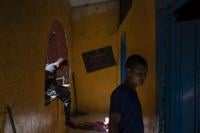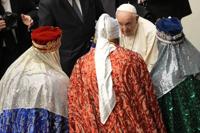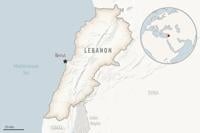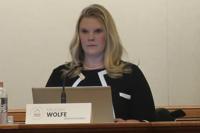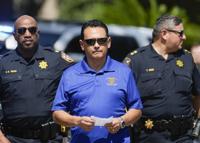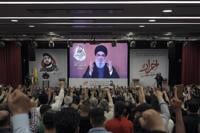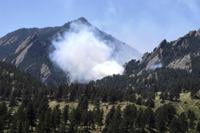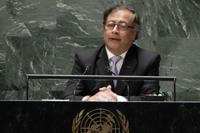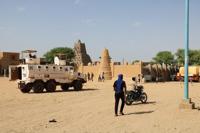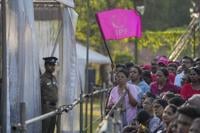TIXTLA, México (AP) — Clemente Rodríguez has been documenting the long search for his missing son with tattoos.
First, it was an ink drawing of a turtle — a symbol of 19-year-old Christian Rodríguez's school — with a smaller turtle on its shell. Then, an image of Mexico's patron saint, the Virgin of Guadalupe, accompanied by the number 43. Later, a tiger for strength and a dove for hope.
“How else is my son going to know that I have been looking for him?” asked Rodríguez. To the heartbroken father, the body art is evidence that he never stopped searching — proof he could perhaps one day show to his boy.
Christian Rodríguez, a tall boy who loved to folk dance and had just enrolled in a teachers college in the southern state of Guerrero, disappeared along with 42 classmates. Every year since, on the 26th of each month, Clemente Rodríguez, his wife, Luz María Telumbre, and other families meet at the Rural Normal School at Ayotzinapa and take a long bus ride to the capital, Mexico City, to demand answers.
They will do so again next week, on of their sons’ disappearance.
“It is hard, very hard,” Clemente Rodríguez said.
There are many questions and few answers
Rodríguez and the other parents are not alone. The 43 students are among more than 115,000 people still reported as missing in Mexico, a reflection of numerous unresolved crimes in a country where human rights activists say violence, corruption and impunity have long been the norm.
Over the years, authorities have offered different explanations. The previous administration of President Enrique Peña Nieto said that the students were attacked by security forces linked to a local drug cartel, and that the bodies were then turned over to organized crime figures, who burned their bodies in a dump and threw their ashes in a river. A bone fragment of one of the students was later found in the river.
President Andrés Manuel López Obrador's administration confirmed the source of the attack. But the current justice department — along with the Interamerican Commission on Human Rights and a Truth Commission formed specifically to investigate the students’ disappearance — refuted the story about the incineration of the bodies in a dump. They accused top former officials of planting the bone fragment in the river to suit their narrative. They also unearthed clues in a different location, including bone fragments from one of Christian's feet.
But the families still don't have any solid answers about what happened to the students. For his part, Clemente Rodríguez is far from convinced that his son is dead.
Parents launch a desperate search for their children
Not long after the students disappeared, parents took matters into their own hands, charging into remote, often gang-controlled mountain towns to search for their children. They encountered others who had been displaced by violence. Fear was everywhere.
“When I left the house, I never knew if I would come back alive,” Rodríguez said.
During the search, Christina Bautista, the 49-year-old mother of missing student Benjamin Ascencio, says strangers told her they'd been searching for a son for three years or a daughter for five. She had thought it would be a matter of weeks.
“I couldn’t take it, I took off running,” she said. “How could there be so many disappeared?”
Dozens of bodies were found, but not those of their children.
A decade of fighting has upended lives
A decade of fighting to keep the case alive has turned the parents’ lives inside out. Before his son’s disappearance, Rodríguez sold jugs of water from the back of his pickup and tended a small menagerie of animals in the town of Tixtla, not far from the school. Telumbre sold handmade tortillas cooked over a wood fire.
When the students vanished, however, they dropped everything. Parents sold or abandoned their animals, left fields untended and entrusted grandparents with the care of other children.
Rodríguez, 56, has since managed to partially reassemble his clutch of livestock and has planted some corn on the family's plot of land. The family's main income, however, comes from homemade crafts sold on trips to Mexico City: mats woven from reeds; bottles of an uncle's locally brewed mezcal decorated with twine and colorful tiger faces; and cloth napkins embroidered by Telumbre.
Sometimes the stocky, soft-spoken Rodríguez visits his land to think or to release his anger and sadness. “I start to cry, let it all go,” he said.
Parents find support and respect at Ayotzinapa
Parents also find solace at the Rural Normal School at Ayotzinapa.
The school, which trains students to teach in poor remote villages, is part of a network of rural educational facilities with a long history of radical activism. School walls painted with slogans demanding justice for the missing students also display murals honoring Che Guevara and Karl Marx.
For the poorest families, Ayotzinapa offers a way out: Students receive free room, board and an education. In exchange, they work.
The atmosphere has militaristic undertones: New students’ heads are shaved and the first year is about discipline and survival. They are tasked with tending cattle, planting fields and commandeering buses to drive to protests in the capital. The students who disappeared in 2014 were abducted from five buses they had taken over in the city of Iguala, 120 kilometers (75 miles) north of the school.
Parents arrived at Ayotzinapa little by little from villages deep in the mountains. They gathered on the school’s basketball court, a concrete pad under a pavilion where 43 chairs still hold photos of each of the missing students.
In the years since, a certain codependency has developed. The school's fight for justice is fueled by the parents' grief and anger. The school's students, meanwhile, “are our strong arm,” Bautista says. “Here is where the movement started.”
Students treat the parents respectfully and affectionately, greeting them as “aunt” or “uncle” as they pass through the guarded gates.
Another meeting ends in disappointment and anger
In late August, Rodríguez and other parents met for the last time with López Obrador, who leaves office at the end of this month.
The exchange was a grave disappointment.
“Right now, this administration is just like that of Enrique Peña Nieto,” Rodríguez said. “He’s tried to mock us” by hiding information, protecting the Army and insulting the families' lawyers, he said.
López Obrador continues to insist that his government has done its best to find answers. He cites dozens of arrests, including that of a former attorney general charged with obstructing justice. He has downplayed the role of the military, however. Years ago, López Obrador declared the students’ abduction a “state crime,” pointing to the involvement of local, state and federal authorities, including
The families met in July with López Obrador’s successor, Claudia Sheinbaum, who will take office Oct. 1, but she made no promises or commitments.
After the August meeting, Rodríguez posed for a portrait in the ������ϲʹ������� Palace, his gaze firm and his fist raised.
Like other parents, he vows to keep fighting.
“During these 10 years, we have learned a lot about obfuscation ... lies,” Rodríguez said. Top military and government authorities “have the answers,” he added.
“They can reveal them."


